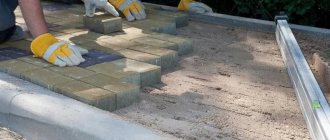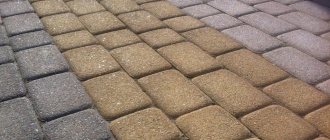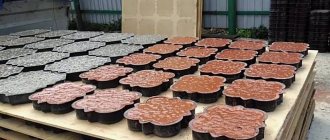By laying paving slabs in the courtyard of a private house or an alley along the site, you can not only achieve a practical and durable result, but also decorate the area in an original way. The article will talk about various methods and basic schemes for laying paving slabs. Technological processes and necessary materials will be discussed.
At first glance, a simple technology that requires certain skills and knowledge Source versiya.info
Laying methods
There are three main options for laying paving slabs. The main differences lie in the base; here they can use just sand, a mixture/mortar using sand and cement. When choosing any option, it is necessary to prepare a high-quality foundation. For example, if the tiles are laid on soil with grass, then crushed stone is additionally used for leveling. Then a base of 5-10 cm of sand is made. After this, the surface is compacted or watered. It is necessary to place curbs on the sides so that the path that has not yet set does not “diverge” to the sides. The curbs will continue to retain the shape of the path or platform.
Whatever option is chosen, the foundation requires good preparation Source zabor.bz
For paths in the garden, the material can be laid directly on the sand, but it must still be wet. Water does not collect on such a path; it is absorbed at the seams. This is the simplest option, but such technology will not be able to withstand heavy loads. In the second case, a mixture is prepared in a ratio of 5 parts sand and 1 part cement. It must be evenly distributed, after which you can begin the installation process. At the end of the work, the entire surface is filled with water, which ensures good adhesion. However, the most reliable is the use of a solution, although the process will be the most labor-intensive, costly and time-consuming. The ratio of materials is identical to the previous method, the solution is laid out on the base and then the tiles are laid.
Laying tiles with mortar takes the longest Source eyecorrector.ru
Final work
The purpose of this stage is to fill the seams between the paving stone elements. To do this, use a mixture of fine sand (sifted) and cement. The ratio of binder and filler is 1:5. The ingredients are thoroughly mixed in dry form, and then the mass is poured onto the surface of the masonry. Use a brush or broom to push the dry mixture into the cracks, trying to pack them as tightly as possible. Then the path is watered and left for 3-4 days for the cement to set and dry. After this, the procedure is repeated, ensuring that the seams are filled to the surface level. Sometimes the seams are filled with a liquid solution of cement and sand (the proportions are the same - 1:3). The solution is applied directly to the masonry and stretched with a spatula, rubbing into the seams. The remaining solution is removed with a dry cloth after drying.
Laying options
Paving should only be carried out by a specialist. Any violation of technology or non-compliance with the rules leads to the fact that after the first rain or heavy load the masonry can deteriorate significantly and everything will have to be redone. Also, a good master will be able to offer different styling options.
- Brick. The easiest way to lay paving slabs is with bricks. Its main advantage is the saving of materials. Originality can be achieved by alternating different shades.
Sidewalk with brick laying Source ogorod.ahuman.ru
See also: Contacts of construction companies that offer the service of developing and implementing landscape projects.
- Herringbone. One of the most popular methods is to lay the tiles at an angle. Guarantees high stability of the coating, often used in the construction of driveways. However, it is important to remember that the area may visually decrease or increase depending on the chosen angle of the masonry. Imitation of weaving is carried out using longitudinal and transverse directions of masonry with alternation.
The elements are laid at right angles Source api.selcdn.ru
- Chaotic order. Tiles are used that differ in shade and size. Any masonry order can be used, and the result is very interesting. This type of masonry combines very favorably with other paving methods.
With this layout you can create drawings Source planetanovosti.com
- Chess. Material laid out in this way always looks neat. The symmetry of squares is used, the best option for a strict design. The tiles can have a textured surface and alternate color shades.
Checkerboard layout Source sy.grupoquepasa.com
- Diamonds. There are many masonry options for using this scheme. It can perfectly harmonize different shades. Curly designs in the center look great on round platforms. Be sure to initially make a drawing diagram of the drawing. The special skills of the master will even allow you to achieve a 3D effect.
Tile diamonds will help create a three-dimensional pattern on the sidewalk Source pinterest.ru
- Circles. Such examples of laying paving slabs are carried out using different patterns, details, shapes and shades, which are laid out radially. Here the master can show his imagination and get very interesting results. Suitable for sites of various sizes.
Using circles you can also create an interesting styling Source kankrit.ru
Properties and dimensions
The dimensions of clinker, both tiles and paving stones, vary over a fairly wide range, but are necessarily related to thickness. Moreover, the shape of the paving stones is in any case rectangular, that is, with a length-to-width ratio of more than 4, and the shape of the tiles is approximately square, that is, with a length-to-width ratio of less than 4.
- Thus, the length of the product ranges from 160 to 420 mm, while there are no tiles with dimensions of 160 mm: with a thickness of 40 to 120 mm, only paving stones are produced. A tile 180 mm long has a thickness of 40 mm; all other types of material with this thickness are called paving stones.
- But the maximum length - 420 mm - is only available in tiles with a thickness of 40 to 120 mm.
The dimensions of the product can be very arbitrary, since, unlike paving stones, they can have very different shapes:
- rectangular and square - including a crossbar format that imitates antique masonry. The classic version, universal for any site - from a decorative pool to a pavement, is marked with the letters K and P;
- honeycombs are hexagonal elements, geometrically regular, indicated on packages by the letter Ш;
- maple leaves - a figured triangle, creating a very decorative complex surface;
- thread spools - a peculiar name, which, however, accurately describes the shape of the products;
- paving mosaic - a block of 4 or 8 small cubes;
- fleece - has rectangular proportions, but with a wavy side;
- flower, clover, cobweb and so on - complex figured tiles that form a real ornament;
- landscape crevice - includes holes for grass germination.
In addition, special tiles are produced for borders - used when laying hexagonal products, as well as road decorative elements - borders, for example.
All shaped elements are marked with the letter F. It is worth noting that their strength is lower due to their complex shape, and therefore this option is only suitable for pedestrian areas.
The color range of clinker is extremely rich. All colors are used here, both natural shades and the most unusual ones. And, since mineral pigments are used for coloring and added to the initial mixture, the color of the clinker does not change during the entire period of operation.
Variations in the shape and color of the material allow you to create a real masterpiece.
This is interesting: How to glue wallpaper end-to-end
Paving pattern
The choice of an interesting and suitable pattern for laying paving slabs may depend on a number of important factors that can greatly influence the choice of materials, their quantity and the additional work required:
- features of the terrain on which the work will be performed;
- the shape and size of the path or area being developed;
- architectural features of the buildings that are located around;
- the final purpose of the future site.
Properly laid out high quality material can last up to fifty years. Therefore, you should choose a drawing very carefully and carefully. Mostly for private houses, rectangular tiles are chosen, which are considered classic. Patterns are created by alternating colors or sizes of tiles used. Working with figured tiles is much more difficult, but it allows you to get a very interesting result.
A large selection of tile colors is an opportunity to create masterpieces on the paths Source eurolain.ru
Programs for laying out paving slabs
Drawing up a diagram for laying FEM on paper is a lengthy process and not very simple. In this case, computer programs come to the rescue, which will help you create samples of the layout of paving slabs.
The graphical editor Microsoft Publisher is convenient for ordinary users. It is present in the Microsoft Office software package. Advantages of this editor:
- the ability to create templates for various types of tiles, which can then be easily inserted into the workspace;
- a large number of graphic tools with which you can create quite complex objects;
- the ability to save files in your own format or others, export them, and use them in other programs.
Another software for visualizing the design of a site with paving stones is the PC application “Paving Slab Designer”. It makes it possible to design the design of a tile covering, calculate the amount of materials, if necessary, replace the color of individual FEMs in an already created project, and print the result.
Publication date: 07/22/2020
Expert author: Stepan Vasiliev
Expert in quality control and permitting documentation.
Education:
2000 - Rudny Industrial Institute, majoring in civil engineering "Industrial and civil construction"
Experience:
Carrying out work to control the quality of products manufactured by the enterprise, in accordance with the requirements of standards and technical specifications, approved samples (standards) and technical documentation.
Share link:
We produce and offer products:
- Paving stones 7P.6 gray
Price: 605 RUR/piece.
Add to cart
- Paving stones 7P.8 gray
Price: 825 RUR/piece.
Add to cart
Styling tips
When purchasing material, you must remember that there will be a certain amount of tile waste in the form of trimming elements. At the same time, you cannot purchase tiles strictly for a certain quantity for a designated area; there must be a small supply. This is due to the fact that during transportation or working with the material, defects may form. In addition, if there is not enough material, you will need to buy more, and the next batch may already have a different shade, which will immediately catch your eye against the general background. It is also not recommended to purchase very bright tiles, since a large amount of pigment leads to a decrease in the strength of the material.
It is better if the tiles have slightly muted shades Source sc-os.ru
You can carefully split the tiles only if they have been previously trimmed using a grinder. You can completely saw the required element, but this takes more time and materials. If the work is carried out to create a platform for parking a car, then a reinforced concrete base is required. The tiles themselves can have different thicknesses - from 4 to 10 cm. For pedestrian paths, material 4 cm thick is used; if constant movement along the alley on bicycles is planned, then the thickness of the tiles should be at least 6 cm. For movement and parking of passenger cars, the use of tiles is required thickness of at least 8 cm, and for the movement of trucks - at least 10 cm.
Features of choosing paving stones
Nowadays the construction market offers a wide range of road surfaces. The owner of the site must, first of all, decide which area he is going to pave. The aesthetic and performance characteristics of the bars directly depend on this.
Parameters that determine the purpose of the material:
Thickness
- Bars up to 30 mm thick are suitable exclusively for pedestrian areas.
- Park areas and recreational areas with increased traffic are paved with elements from 50 to 60 mm.
- For the construction of access roads and parking for cars and trucks, stones over 80 mm are used.
Advice from the experts! When purchasing a batch of bars, knock the tiles together. A dull sound indicates that the production technology of the product has been violated (insufficient drying).
Also, the product must be accompanied by a quality certificate, which reflects such characteristics as:
- Frost resistance. The indicator indicates the number of freezing and thawing cycles that the bars can withstand. For example, in the middle zone, temperature changes vary from - 25 ° C to + 25 ° C, with a frequency of 5 to 7 times. This means that the service life of tiles with a frost resistance of 200 and with 5 cycles of temperature changes will be equal to 40 years.
- Strength. Strength indicators are assessed according to three criteria: bending (resistance to oblique loads, value from 60 kg/cm²), compression (impact of vertical loads with a value from 400 kg/cm²), abrasion (for paving stones this indicator should be less than or equal to 0.4 kg/cm2).
- Water absorption. The indicator is measured as a percentage. Moreover, the lower it is, the better. For example, if the value is 1.5%, then in this case the material will absorb water at the rate of 15 g per 1 kg of paving stone weight.
Form
Decorative wave paving stones
The configuration of the elements does not affect the strength of the paving stones. Therefore, the choice of decorative elements depends on the personal preferences of the owner of the site.
Landscape designers recommend selecting several coating options. The original composition will enliven the area.
The construction market offers decorative tiles in the shape of clover, wave, parquet or honeycomb.
You can lay the bars according to your own sketch, or contact the designers.
Video description
The video shows the types of paving slabs:
Clover-shaped tiles are made of concrete with the addition of fine crushed stone. It has a very smooth surface and can be washed. Another option is English cobblestones. Such tiles can only be obtained by the vibration casting process; they imitate natural stone in color and shape, and generally have a brown or gray tint. There are bars in the shape of a wave; they are quite narrow and elongated, with a slight bend. It is this bend on the surface that creates the impression of a wave. However, brick remains the most popular and inexpensive option. It has a regular elongated shape, is characterized by high strength and long service life. Galvanized with curves has unlimited design possibilities, but the design is not very durable. These are the basic and most common options, but there are other types.
Paving slabs “Wave” Source uabruk.com.ua
What are paving stones
Since ancient times, the raw materials for the production of this building material have been roughly processed natural materials (wild stone, granite, marble, gabbro, diabase, sandstone), hewn to a rectangular shape.
Due to the high cost of the natural product, the modern production of road surfaces began to use concrete or polymer concrete, which are not inferior in their performance characteristics to natural structures. And in some respects (weight, processing, price) it is better.
- By vibration casting or vibrocompression, bricks of any shape are obtained;
- By adding dyes to the mixture, paving stones can be made in a variety of colors;
- Production technology allows us to obtain elements with a smooth and even surface;
- The exact dimensions of the products make it easier to fit them when laying.
Another type of modern path covering is clinker paving stones. It is made from ordinary brick. To increase wear resistance, the bars are pressed, tinted and fired. Therefore, this type is more expensive than products made from cement or concrete mixtures.
First way
Before laying the brick itself, it is advisable to water the sand generously and let it soak into it. After this, the top tile layer is laid on the wet sand.
The suggested installation method is the easiest to use. It is ideal for laying country, park or garden paths. Rain has virtually no effect on its outer covering and condition; water seeps through the joints of the tiles and is absorbed by the sand.
But the integrity of the stone path on such a cushion will depend entirely on the skill of a professional - he must lay it carefully, joint to joint, otherwise individual fragments will begin to loosen and fall out.











